Easy homemade kimchi 🫙🥬
Making your own probiotic fermented foods at home is healthy, fun, and cost-effective!
I’m going to do the recipe writer thing here and blab a bit so if you just want my kimchi recipe, you can jump to it here.
I love fermenting my own veggies at home!
The process of pickling and fermenting vegetables goes back to ancient times, as it was a means to preserve foods in a tasty way before the times of modern refrigeration. Many civilizations across the globe continue to make fermented foods a staple in their diets―with research showing that the consumption of these probiotic-rich foods has correlated to longer average lifespans in these communities.
Fermented cabbage, like kimchi and sauerkraut, are some of my favorite probiotic veggies to eat for good gut health. They are pretty easy to make yourself at home, even without fancy fermentation technology! Fermenting your own foods is also ultimately more economical than buying them in the store.
The benefits of probiotic foods
Our guts need a diverse range of good bacteria to maintain a healthy balance. Many doctors and health practitioners recommend supplementing with a probiotic, which can be a great way to ensure your gut microbiome and metabolome get face-time with beneficial good bacteria. However, probiotic foods, like kimchi, sauerkraut, yogurt, and more, are live foods that are naturally packed with these good bacteria, and consuming them regularly can help us to keep our gut flora flourishing.
Kimchi is a Korean fermented cabbage. It’s a staple in the Korean diet, accompanying many meals as a banchan, or side dish. The pickled vegetable dates back before the common era, with it being cited as early as the period of the Three Kingdoms of Korea, of which the people of the Goguryeo Dynasty were known to be avid fermenters and for whom fermented foods made up a large part of their diet.

The dish is made with red Korean gochu chili peppers, which gives it its trademark vibrant red color and spiciness. However, the level of spiciness in kimchi can be customized by adjusting the amount of pepper flakes or pepper paste used when making it. Being a traditional fermented food, there are naturally very many health benefits. There is even a study that showed that kimchi and other fermented cabbages could enhance antioxidant protection in the mitigation of COVID-19 and some of its studied long-term side effects, including insulin resistance and lung/blood vessel damage.
Other benefits
Cabbage supports detoxification and hormone metabolism
Nuclear factor 2 or Nrf2 is known to be one of the most powerful antioxidants for humans. Cabbages (and not just your standard green and red cabbages, but also napa cabbage, bok choy, komatsuna, and the many other cruciferous veggies of the Brassicaceae family) are a rich source of precursors to sulforaphane, an antioxidant and anti-inflammatory compound that supports our bodies’ natural detoxification process. Sulforaphane is also one of the most effective natural activators of the Nrf2 antioxidant. Diindolylmethane (or DIM), a compound that helps the body metabolize estrogen for hormonal balance, is also potent within cruciferous veggies like cabbage.
Harnessing the antioxidant power of fermented cabbage
It was found in the study cited above that the lactobacilli present in fermented foods, like sulforaphane, are strong activators of the Nrf2 antioxidant. However, sulforaphane content can be diminished when these vegetables are cooked, including through heat, altering their pH, or salinity (i.e. salting them, which could happen through the process of lacto-fermentation and making kimchi). For this reason, I like to add ground mustard seed powder when prepping my cruciferous veggies (cooking and fermenting) as it helps to reactivate the sulforaphane and DIM compounds via a process called glucoraphanin hydrolysis.
The gut-brain connection
There is a strong connection between the gut and the brain, and our gastrointestinal tracts communicate with our brain’s central nervous system bidirectionally. Serotonin, dopamine, and cortisol flow between the brain and the gut to regulate stress, mood, and appetite. It’s been found that the gut microbiota is connected to mental health, and dysbiosis or imbalance in the microbiota has been associated with mental disorders like anxiety, depression and more. Therefore, a diet that contains probiotic-rich foods can contribute to managing mental wellbeing.
Science aside, kimchi and other fermented foods are traditional and ancestral, and hold the wisdom of how our global ancestors nourished their bodies for good health for centuries.
My kimchi recipe is by no means traditional by Korean standards, but I wanted to share how easy it is to make a dish like this for yourself at home to enjoy its flavorful benefits.
Here’s how I make it.
〰
Kendyl’s Easy Homemade Kimchi
What you’ll need
1 large napa cabbage, bunch of komatsuna Japanese mustard greens, bunch of bok choy, or any blend of these greens, chopped
1 large or 2 small daikon radishes, sliced into thin or quart-inch thick medallions, or chopped into chunky quarters
1-2 medium carrots, julienned or ribboned with a vegetable peeler
a couple tbsps gochugaru Korean red pepper flakes or gochujang Korean red pepper paste, enough to cover and massage greens with, can adjust to taste and for spiciness
1-2 tbsps good salt, I use Redmond’s pink mineral salt—use much less if you are using gochujang paste instead of flakes, as it’s already salted—you can taste to check
1 leek, sliced and/or 3-4 whole scallion stalks, chopped
2-3 cloves garlic, chopped, minced, or grated
1-2 inches fresh ginger, grated
1 big bowl (I’ve sometimes used a large pot, haha)
1-2 clean mason jars, quart and pint sized for stuffing your kimchi with
plastic lids or parchment paper for covering under metal lids, as the acidity of the fermented kimchi can react with and rust metal lids (I use these lids made by the Ball brand for my mason jars)
Optional:
1/2 tbsp fish sauce
1 tbsp dried wakame seaweed — the kind added to miso and other soups, adds a nice serving of iodine to your bite of kimchi
1 tbsp dried dulse seaweed ― for its iodine, vitamin and mineral content, and its detoxification support properties
1 tbsp of minced fresh nettle leaves or dried nettle — for its high vitamin and mineral content and antihistamine allergy-defense support
1 tsp ground mustard seed powder ― can improve absorption of sulforaphane and DIM compounds in cabbage greens
cooking gloves for massaging pepper flakes/paste into the veggies, if you don’t want to get messy
glass fermenting weights
Making it
Prep all of your vegetables. I give some suggestions for how you may want to cut them, but I encourage you to cut and prep them into any shapes or forms that you like. Add all cut ingredients into a big, clean bowl. Pour over your salt and gochugaru chili flakes, OR spoon in the gochujang chili paste (already salted). Add in fish sauce now, if using.
Use clean hands to massage flakes/paste/salt blend into the cabbage and vegetables, until the leaves of the green cabbage leaves start to wilt and become tender. You may choose to let your cabbage and veggies sit for a while after massaging to encourage more water to come out of the veggies so that you get a nice brine to pour into your jars for fermenting.
Grab your jars, and start packing in your kimchi. You’ll want to fill a jar as much as possible. You may optionally choose to add a glass fermentation weight on top, to push everything down in the jar and encourage fermentation, however, if you pack your jar well enough you won’t need it.
Fermentation time varies, depending on how sour you like it. The longer you let your kimchi ferment at room temperature, the more tangy and probiotic-rich it will get. I let mine sit for at least 3 days, in the dark corner of my kitchen counter.
It’s also helpful to sit packed-to-the-brim jars in a shallow bowl or dish to catch any kimchi juice that may overflow from fermentation. Check daily and give your kimchi a taste test. Once it’s to your liking, store it in the fridge, and enjoy!
If you have any leftover juices after packing your jars with kimchi, you can carefully pour the excess into the jars or save it for cooking or as a condiment for your next meal!
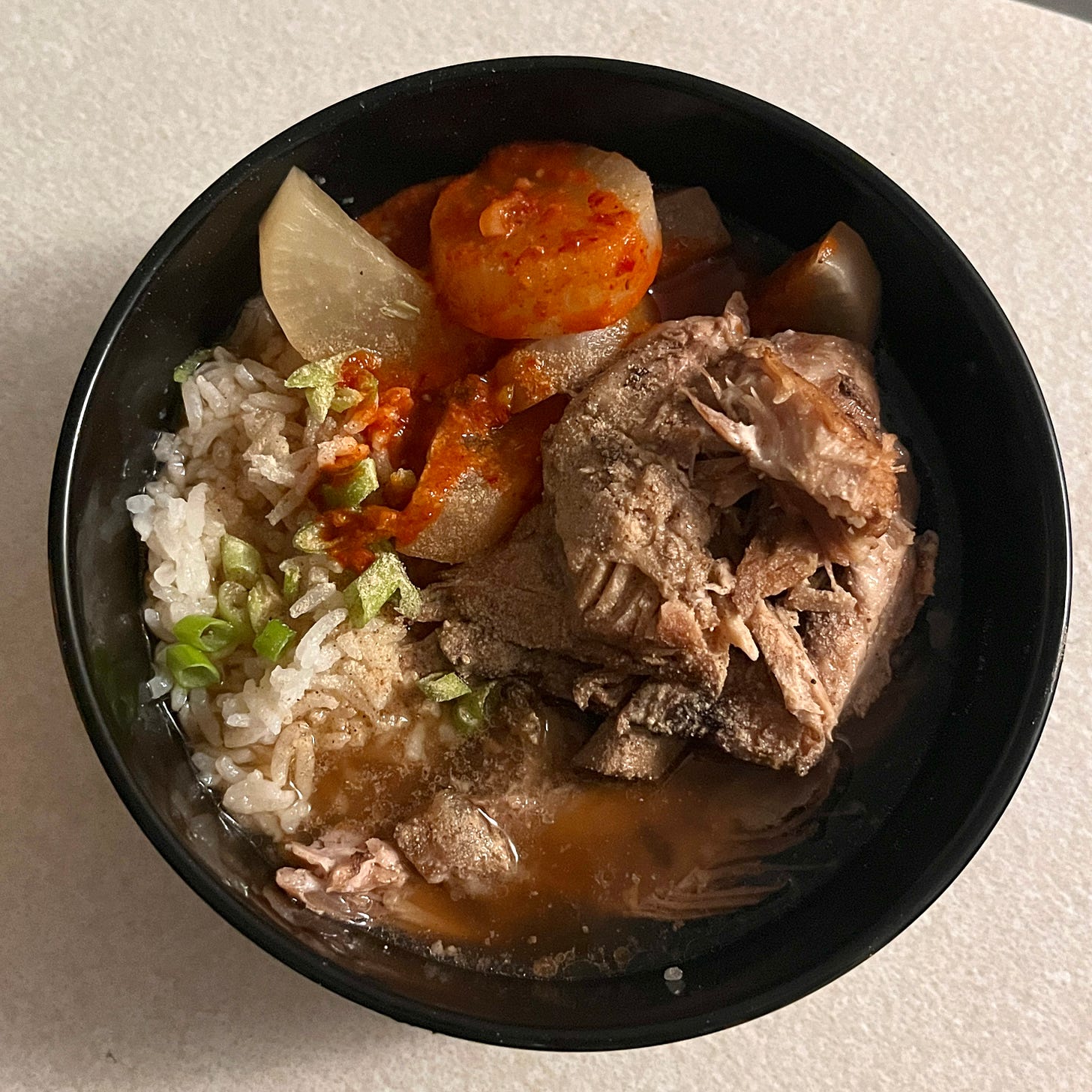
No need to buy kimchi ever again.
I know I haven’t, ever since I started making it at home!
Let me know if you want any more fermentation recipes and ideas.
〰
Yours in nourishment,
Liked what you saw here? Follow garlic and dyl on Instagram for more holistic wellness.


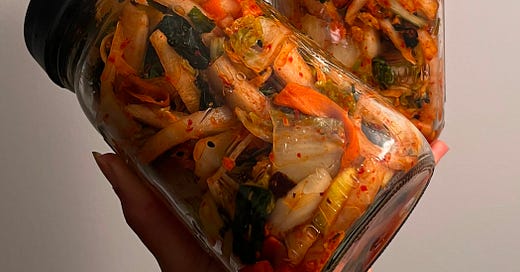




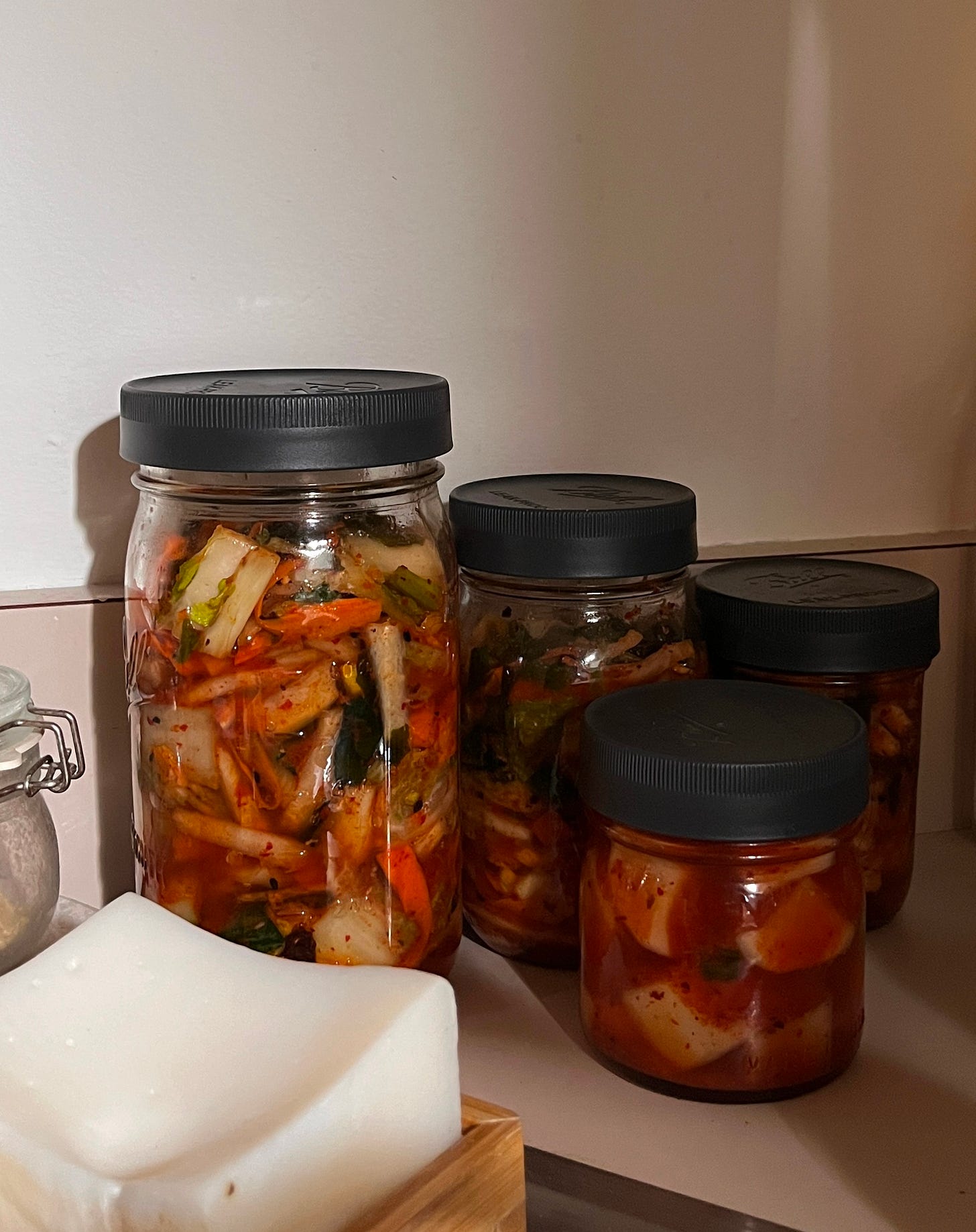
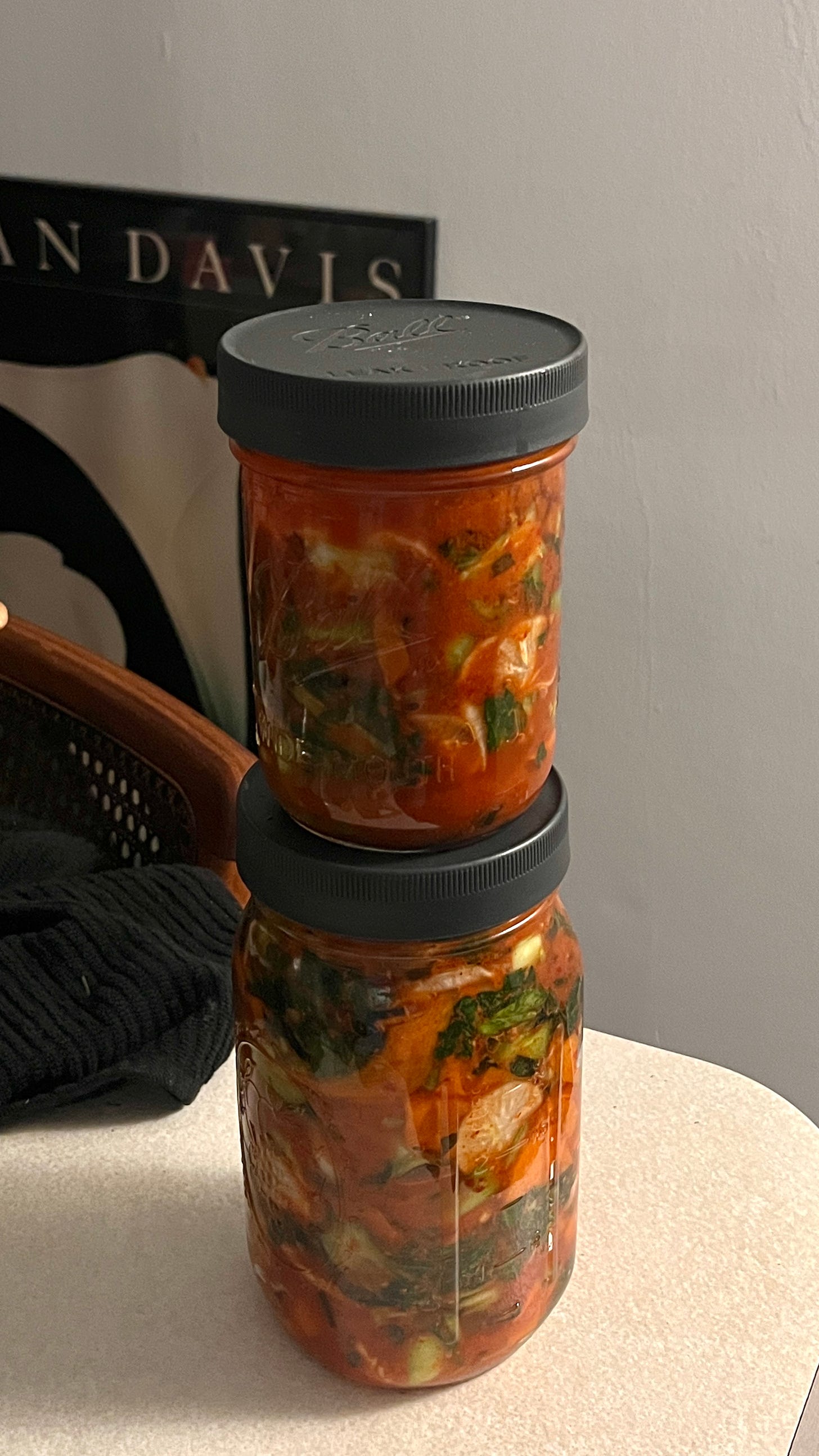
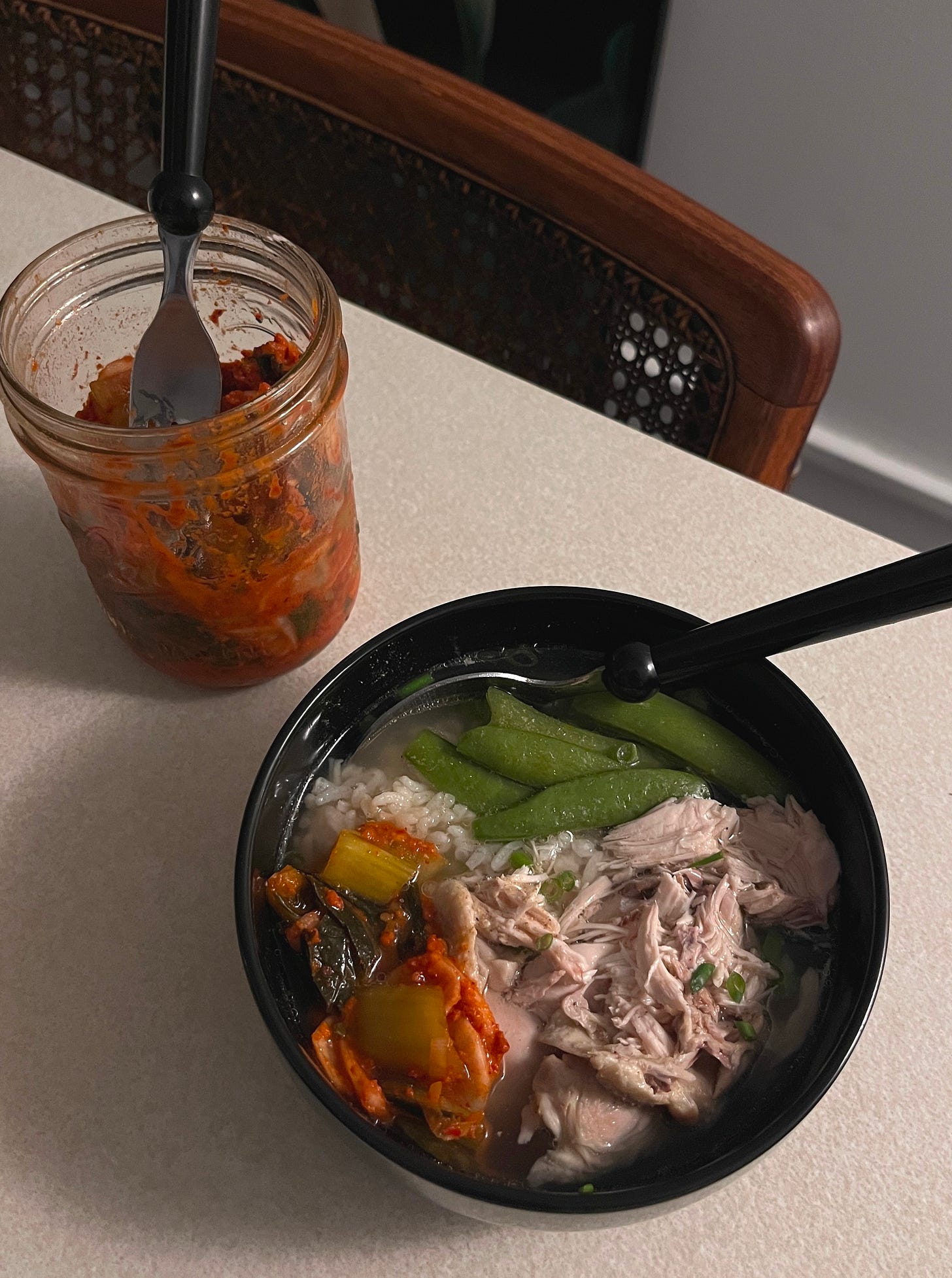

yessss i was waiting for this one!! thank you for hooking us up 🫂